Was. Für. Ein. Abend! Der FC St. Pauli gewinnt im DFB-Pokal gegen Borussia Dortmund und steht damit im Viertelfinale. In einem intensiven Spiel schaffte es der FCSP mit neuem System und ganz viel Einsatz die hochwertig besetzte Dortmunder Offensive in Schach zu halten. Der verdiente Lohn ist das DFB-Pokal-Viertelfinale!
(Titelbild: Peter Böhmer)
Geradezu standesgemäß für ein Pokal-Achtelfinale wurde der Teambus des FC St. Pauli mit ordentlich Pyrotechnik von der Budapester Straße bis zum Stadion begleitet. Trotz der wenigen Zuschauer im Stadion, war von der ersten Minute an richtig was los und sowohl auf den Rängen, als auch auf dem Platz wurde Alles für ein erfolgreiches Spiel gegeben.
Die Aufstellung
Gleich drei Veränderungen gab es beim FC St. Pauli im Vergleich zum Spiel gegen Erzgebirge Aue. In der Innenverteidigung startete James Lawrence anstelle von Philipp Ziereis. Lawrence übernahm damit auch die Kapitänsbinde von Ziereis und sollte ein sehr unangenehmer Gegner für Erling Haaland werden. Sehr selten passt es mit der wirklichen Startelfaufstellung, was ich im Vorbericht vor mich hin schrubbe, aber dieses Mal schon ein bisschen mehr: In der Mittelfeldraute kam Finn Ole Becker für Christopher Buchtmann rein. Zudem startete Etienne Amenyido an der Seite von Guido Burgstaller im Angriff. Im Kader fehlte Igor Matanović, der laut Schultz „leicht kränklich“ war. Dafür kehrten Simon Makienok und Luca Zander wieder zurück in den Kader (und später auch auf den Platz).
Bei Borussia Dortmund gab es ebenfalls einige Wechsel im Vergleich zum erfolgreichen Spiel am vergangenen Wochenende: In der Innenverteidigung ersetzte Manuel Akanji den verletzten Emre Can. Thomas Meunier wurde doch noch rechtzeitig fit und spielte auf der rechten Abwehrseite. Im defensiven Mittelfeld ersetzte Axel Witsel kurzfristig Mo Dahoud, der aufgrund von Oberschenkelproblemen gar nicht im Kader stand (eine enorme Schwächung, wie sich beim Spiel zeigen sollte). Auf der offensiven Außenposition brachte BVB-Trainer Marco Rose zu Beginn Thorgan Hazard für Donyell Malen ins Spiel.
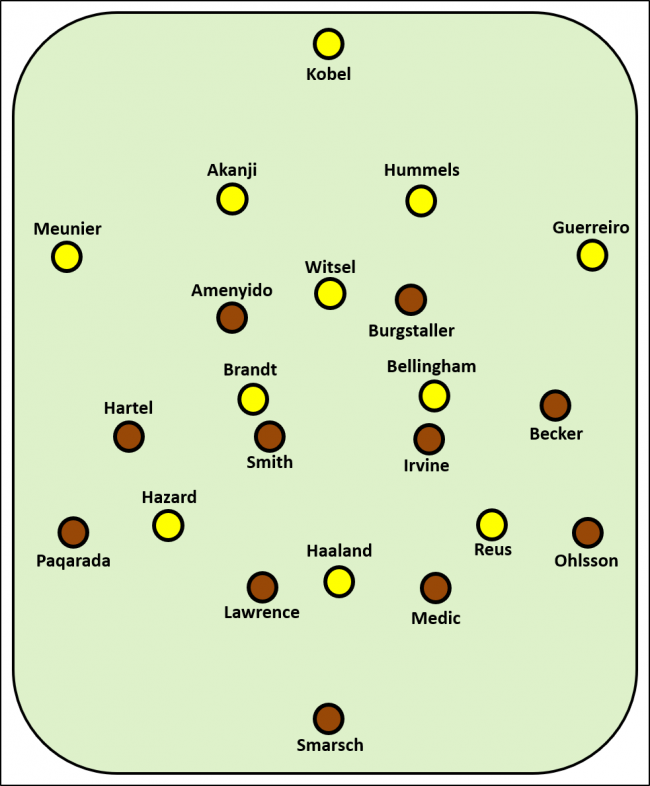
Immer wieder: Früher Vogel
Es sollte sich inzwischen rumgesprochen haben, was da in dieser Saison am Millerntor kurz nach Anpfiff passiert: Der FC St. Pauli ist ein früher Vogel. Immer wieder. Was gegen Erzgebirge Aue ausnahmsweise mal nicht klappte, haute gegen Dortmund umso besser hin. Der FCSP ging ganz früh in Führung. Wie in dieser Saison schon gegen Kiel (11. Minute), Dresden (2. Minute), Rostock (12.) und auch gegen Schalke (20.) – der FC St. Pauli setzte ganz früh ein dickes ein sehr dickes Ausrufezeichen.
In der Entstehung wurde auch gleich klar, dass die Hereinnahme von Finn Ole Becker eine gute Idee war: Er zeigte, was sein größte Stärke ist und spielte eng bedrängt von gleich vier Dortmundern einen Pass ins letzte Drittel zu Jackson Irvine. Der leitete nach rechts in die Tiefe zu Hartel. Das ist noch so eine Änderung, die sich direkt zu Beginn bezahlt machte: Irvine agierte laut Schultz offensiv auf der Zehner-Position, bewegte sich aber immer wieder nach rechts raus (weshalb ich es fast eher als 4-3-3 bezeichnen würde, wie sich der FCSP offensiv aufstellte). Marcel Hartel bewegte sich in der Situation ebenfalls weit nach draußen und noch tiefer. Auch das, die tiefen Läufe der beiden Achter, ist eine Maßgabe des Trainer-Teams.
Hartel spielte den Pass rein zu Etienne Amenyido, der nun auch im zweiten Spiel nach der Winterpause zeigte, dass er Tore schießen kann. Timo Schultz sagte bei uns im Podcast „Wir sehen in Eti unglaublich viel“ und gestern konnte man in einigen Situationen wieder erkennen, was er damit meinte (und es zeigte sich auch, dass die von mir im Podcast aufgestellte These, dass Amenyido kein Torjäger sei, ziemlicher Humbug ist). Das 1:0 von Amenyido war jedenfalls der perfekte Start in ein immer aufregender werdendes Pokalspiel. Nach zwei gespielten Minuten wurde aus einem schönen und gemütlichen Pokalabend, den sich der FC St. Pauli verdient hat, urplötzlich eine ernste Angelegenheit. Nach zwei Minuten wurde allen bewusst, dass hier richtig was möglich ist an diesem Abend. Es wurde allen bewusst, dass dieser Abend mit einem Spiel gegen den Titelverteidiger zwar der Lohn für zwei erfolgreiche Spiele zuvor war, aber das die Pokalreise des FCSP unerwartet doch noch weiter gehen könnte. Ich hatte jedenfalls mächtig Puls nach zwei Minuten.
Say hello to: 4-4-2(flach)!
Nach diesem perfekten Start musste sich der FC St. Pauli aber erst einmal auf die eigene Defensive konzentrieren. Borussia Dortmund hatte nach dem Tor bis etwa zur 25. Minute das Geschehen voll im Griff und einige gute Offensivaktionen. Zeit also, sich mit dem Defensivverhalten des FC St. Pauli zu befassen:
Seit rund einem Jahr agierte der FCSP fast ausschließlich mit einer Mittelfeldraute, offensiv wie defensiv. Dies änderte sich mit dem gestrigen Abend. Der FC St. Pauli stellte sein System um: Offensiv war es zwar weiterhin ein 4-4-2 mit Raute (und mit Irvine auf der 10), aber defensiv spielte der FC St. Pauli ein klares 4-4-2(flach), also ein System mit zwei Sechsern. Dabei ließ sich Irvine auf die Höhe von Eric Smith fallen, sodass der FCSP eine saubere Viererkette im Mittelfeld bildete.

(c) Peter Böhmer
Dieses System wurde von Minute zu Minute stabiler, musste aber besonders zu Beginn einige schwere Momente überstehen. Mit zwei Viererketten stand der FC St. Pauli vor allem im Zentrum sehr kompakt und konnte so das spielstarke zentrale Mittelfeld des BVB mit Bellingham, Brandt und Reus gut aufnehmen. Allerdings bietet jedes System irgendwo Räume an. Das flache 4-4-2 bietet diese auf den Außenbahnen. Der BVB suchte in der Folge genau diese Räume, schob auf der rechten Seite mit Außenverteidiger Thomas Meunier extrem hoch. Raphael Guerreiro tat das auf derlinken Seite nicht. Er zog meist in den Halbraum und es waren wechselweise Bellingham, Reus, Brandt oder Hazard, die dem Dortmunder Spiel durch eine Positionierung weit links die notwendige Breite gaben. Ja, da waren wirklich alle vier Spieler im Wechsel zu finden. Das BVB-Mittelfeld rotierte enorm viel und die Spieler wechselten fröhlich ihre Positionen. Der FC St. Pauli ließ sich davon aber nicht beirren und löste es mit einer fast konsequenten Raumverteidigung gegen diese Rotationen. So wurde es dann auch meist nur dann richtig gefährlich, wenn der BVB die Seiten massiv überladen hatte, also gleich mit mehreren Spielern auf eine Seite auswich. BVB-Trainer Marco Rose war das aber alles nicht genug. Er monierte auf der PK nach dem Spiel, dass seinem Team „die Breite gefehlt“ habe.
Was dem FC St. Pauli in diesen ersten 25 Minuten gefehlt hat, war die defensive Stabilität bei tiefen Bällen der Dortmunder, wie Timo Schultz nach dem Spiel erzählte. Großchancen gab es für Dortmund dann, wenn die Spieler auf den Außenpositionen tiefe Wege gingen, also aus ihrer Mittelfeldposition im Vollsprint gen FCSP-Tor aufbrachen und mit einem langen Ball gesucht wurden (beim Handball würde man laut „Einläufer“ schreien). So kamen die Großchancen von Hazard (7. Minute) und Reus (17.) zustande. Beide Male tauchten sie komplett frei vor dem FCSP-Tor auf. Da hätte das alles auch ganz anders laufen können… Aber es ist Pokal und das bedeutet, dass wir endlich, mehr als 18 Monate nachdem er beim FC St. Pauli aufgeschlagen ist, mal laut ausschreiben können: SMARSCH! AHAAAAAA… SAVIOR OF THE UNIVERSE!
Es war schlicht großartig, was Dennis Smarsch gestern im Tor des FC St. Pauli gezeigt hat. Nicht nur, dass er diese beiden Großchancen parierte, nein, er strahlte eine bemerkenswerte Ruhe aus. Gerade vor dem Hintergrund, dass er nur im Pokal zum Einsatz kommt, fand ich diese Ruhe, die sich auf die Hintermannschaft auszuwirken schien, bemerkenswert. Entsprechend freue ich mich sehr für ihn, dass er noch (mindestens!) ein weiteres Spiel in dieser Saison bestreiten wird und stelle freudig fest, dass es beim FCSP anscheinend eine echte Luxus-Situation im Tor gibt.
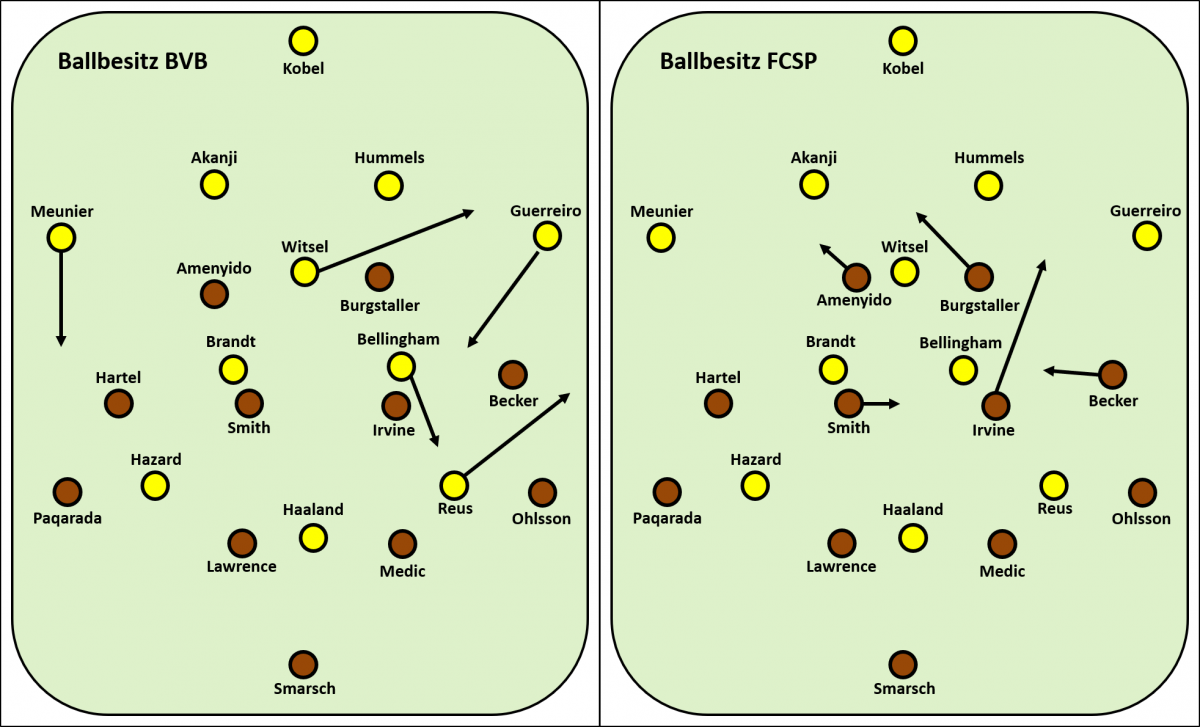
Ab der 25. Minute wurde der FC St. Pauli aber stabiler. Das bedeutete zwar nicht, dass sie mehr Ballbesitz hatten, aber es gelang ihnen nun immer besser, die Räume eng zu halten. Auch dann noch, wenn der BVB versuchte die Breite zu bespielen, zum Beispiel über schnelle Verlagerungen. Schultz hob nach dem Spiel vor allem seine beiden Achter hervor, die diese Situationen „mit viel läuferischem Aufwand klasse verteidigt“ hätten.
Beide sorgten dafür, dass die Formation des FC St. Pauli Dortmunds Achter Brandt und Bellingham gut aufnahmen, ohne die eigenen Außenverteidiger dafür opfern zu müssen und ohne, dass es im Zentrum allzu große Löcher gab.
Es entwickelte sich bis zur Halbzeit ein offeneres Spiel, bei dem es dem FC St. Pauli gelang immer wieder zu entlasten. Das war auch möglich, da das 4-4-2 nun etwas höher stand und den BVB nicht tief in der eigenen Hälfte erwartete, sodass Umschaltmomente als solche ausgespielt werden konnten. Ein solcher Umschaltmoment entwickelte sich dann auch als Jakov Medić in der 40. Minute mutig und kompromisslos gegen Marco Reus vorwärts verteidigte und in der Folge den Weg nach vorne mitging. Sekunden später brachte Burgstaller den Ball ins Zentrum, wo Axel Witsel unglücklich ins eigene Tor abfälschte. Das war fast schon sinnbildlich für den Auftritt von Witsel. Der Ausfall von Mo Dahoud wog dann doch etwas schwerer, als viele vor dem Spiel angenommen hatten. Dahoud hatte in den Spielen zuvor von der Sechser-Position aus sehr viele Offensivaktionen kreiert. Über Witsel lief vor allem in der ersten Halbzeit wenig.
BVB passt und schließt an
Zur zweiten Halbzeit passte der BVB seine Formation dann leicht an. Marco Rose (der auf der PK sichtlich angefressen wirkte) betonte, dass Axel Witsel nun nicht mehr vor der ersten Pressinglinie des FCSP, sondern dahinter agieren sollte und Dortmund allgemein die Schnittstellen besser besetzen und auch, wo war der eigentlich in der ersten Halbzeit?, „mehr Tiefe“ für Erling Haaland erzeugen wollte. Durch die veränderte Positionierung von Witsel konnten die zentralen Mitspieler noch ein wenig weiter hoch oder nach außen schieben.
Rose sagte aber auch, dass er den FC St. Pauli „anders gegen den Ball“ erwartet hatte. Trotz der Umstellung in der zweiten Halbzeit gelang es Borussia Dortmund trotz optischer Überlegenheit nun seltener richtig gefährlich zu werden. Das 4-4-2 des FC St. Pauli entwickelte sich zum undurchdringlichen Bollwerk. Es war fast spürbar, wie die FCSP-Spieler dieser Formation mehr und mehr Vertrauen schenkten, wie sie sich minütlich steigerten und den Fokus und die Disziplin in schweren Phasen nicht verloren.
Trotzdem war sicher allen im Stadion und sonstwo klar, dass der Adrenalinpegel in der 2. Halbzeit minütlich zunehmen würde. Ein Pokalspiel ist ein Pokalspiel. Es ist immer alles möglich. Ich habe das erste Mal in der 47. Minute auf die Uhr geguckt, um zu schauen, wann das Spiel endlich vorbei ist. 47. MINUTE ERST! Die zweite Halbzeit schien bereits ewig zu dauern. Da dämmerte mir umso mehr, dass ich auf der Pressetribüne zwischen hadernden Reportern aus Dortmund einen ganz langen Kampf mit meinen Emotionen vor mir hatte.
Der BVB hatte auch gleich die ersten Offensivaktionen nach der Pause, aber das erste Ausrufezeichen setzte Guido Burgstaller per Kopf nach einem Smith-Standard, der ziemlich stark von Dortmunds Kobel pariert wurde (53. Minute). Kurz danach ein Aufschrei aller Dortmunder Spieler: Die Situation war nicht nur für mich im Stadion schwer wahrnehmbar, aber spätestens als Schiedsrichter Harm Osmers an sein Ohr griff und daraufhin gen Seitenlinie lief, bestand das Millerntor kurzzeitig aus einem lauten Seufzen – Elfmeter für Dortmund. Erling Haaland, bis zu diesem Zeitpunkt überraschend blass und in der Folge noch blasser, verwandelte sicher in der 58. Minute. 35 Minuten noch. Und Dortmund hatte den Anschluss hergestellt. Meine Stimmung war am Tiefpunkt. Trotz Führung war mir klar, dass die Dinge ab jetzt ihren ganz gewöhnlichen Lauf gehen würden. Ich hatte gehofft, dass der FCSP das 2:0 vielleicht 20 vielleicht sogar 25 Minuten halten würde in der 2.Halbzeit. So lange, bis Dortmund nervös und dann auch ungenau werden würde, so wie wir das am eigenen Leib gegen Aue erlebten.
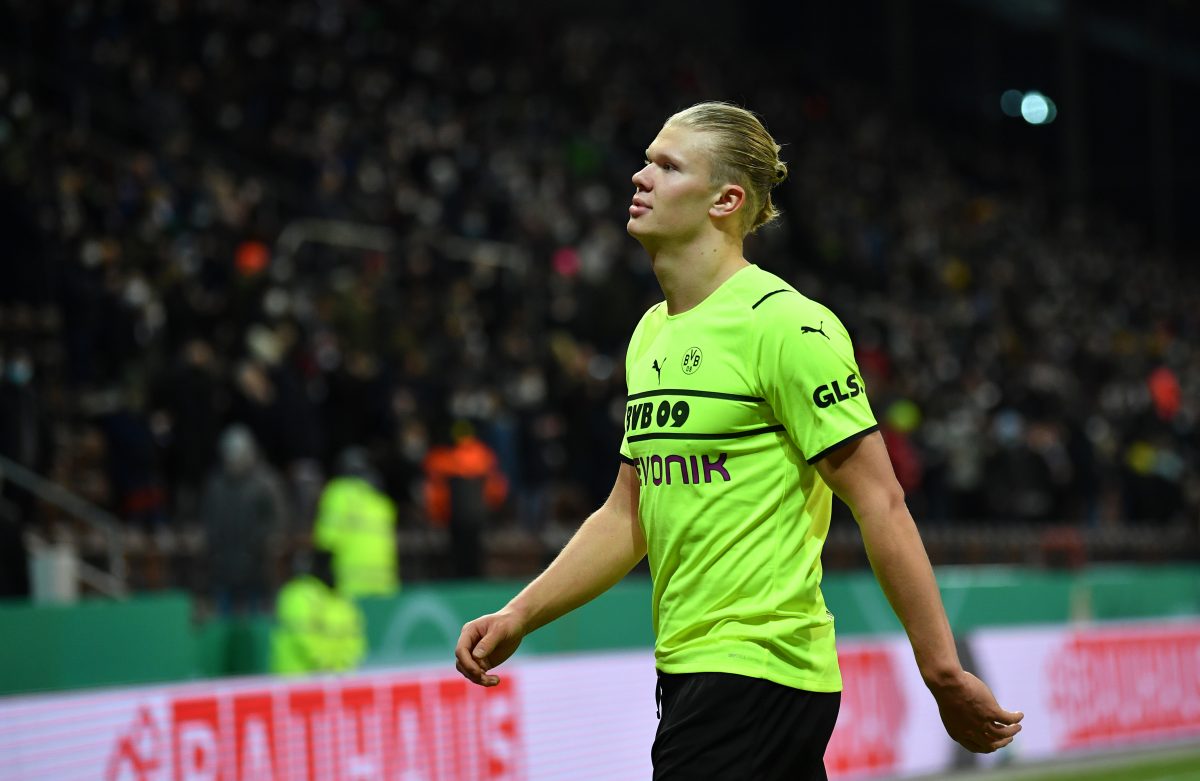
(Stuart Franklin/Getty Images/via OneFootball)
Nervös wurde beim FC St. Pauli aber niemand. Es schien eher so, dass sie nach dem Anschluss ihr System noch disziplinierter spielten. Die Abstände untereinander wurden noch geringer und zudem gelang es immer wieder für Entlastung zu sorgen. Spätestens ab Minute 60 war es dann das, was man einen Pokalfight nennt. Allerdings schien dieser einseitig geführt zu werden. Die Trainerstimmen nach dem Spiel waren da eindeutig gegensätzlich: Rose warf seinem Team vor, dass es „den Fight nicht angenommen“ habe, während Schultz einen „klasse Pokalfight meiner Mannschaft“ sah.
Je länger es dauerte, umso stabiler wurde der FC St. Pauli
Trotz der laut Rose „fehlenden Energie“ blieb der BVB nicht ungefährlich. In der Phase zwischen 70. und 80. Minute ließ sich der FC St. Pauli weit, sehr weit, sicher etwas zu weit in die eigene Hälfte drängen. In den ersten 25 Minuten hatte der BVB etwas größere Chancen, aber diese 10 Minuten Mitte der 2. Halbzeit, sie waren wohl die schwierigsten für den FC St. Pauli. Aber während ich ungeduldig auf die Uhr starrte, ließ sich das Team nicht von seiner disziplinierten Spielweise abbringen, ging weiterhin enorme Wege in der Defensive, hielt damit die Abstände untereinander gering und konnte ein ums andere Mal klären. Da das Team sehr tief stand, kam es aber auch zu sehr wenig Entlastungsaktionen. Wenn der FC St. Pauli den Ball längere Zeit besaß, rückte Jackson Irvine nicht einmal mehr richtig vor und Eric Smith pumpte bei jeder Spielunterbrechung bedenklich.
Es war die hintere Viererkette, die den FC St. Pauli durch diese Phase trug. Eigentlich ist jede Spielphase Spielern zuzuschreiben: Der Start ging an die Offensiv-Abteilung, Smarsch rettete danach mehrmals richtig stark und bis zur Halbzeit war es die gut eingestellte Mittelfeldkette, die dem Dortmunder Spiel den Zahn zog. Mitte der zweiten Halbzeit war es die hintere Viererkette mit dem fantastischen Sebastian Ohlsson, der sich immer wieder wechselnden Gegenspielern auf seiner Seite gegenüber sah und sagenhafte 11 von 13 Duellen gewann (ebenfalls stark: Jackson Irvine gewann 11 von 15 – und Jakov Medić einfach alle(!) seine direkten Duelle am Boden…).
Der FC St. Pauli blieb diszipliniert in seinem 4-4-2, Dortmund wirkte zunehmend entnervt und auch etwas ratlos. So ab der 80. Minute war zu spüren, dass der BVB irgendwie ein wenig gebrochen schien. Es gab auch wieder mehr Entlastungsaktionen. Guido Burgstaller trat nun vermehrt in Erscheinung, konnte viele Bälle vorne fest machen und Zeit gewinnen (es war dann die Phase von ihm – unfassbar wie der selbst noch kurz vor Ende konsequent die Gegner im Vollsprint anlief). Ganz zum Ende des Spiels, als Mats Hummels bereits seine Position aufgelöst hatte und vorne drin stand („hat es jemals was gebracht, dass der da vorne drin steht?!“ war der entnervte O-Ton der Reporter neben mir) ergaben sich auch sehr gute Kontermöglichkeiten für den FC St. Pauli. Die waren so gut, ich hätte nachträglich in den Tisch gebissen, wenn der BVB noch ausgeglichen hätte.
Taten sie nicht. Nein, sie taten es einfach nicht. Mit unglaublichem Willen, eiserner Disziplin, lautstarken 2.000 Zuschauern im Rücken und natürlich auch der notwendigen Portion Glück, brachte der FC St. Pauli die knappe Führung über die Zeit – Pokalsiegerbesieger, Viertelfinale, gefühlt schon qualifiziert für den Weltpokal – großes Kino!
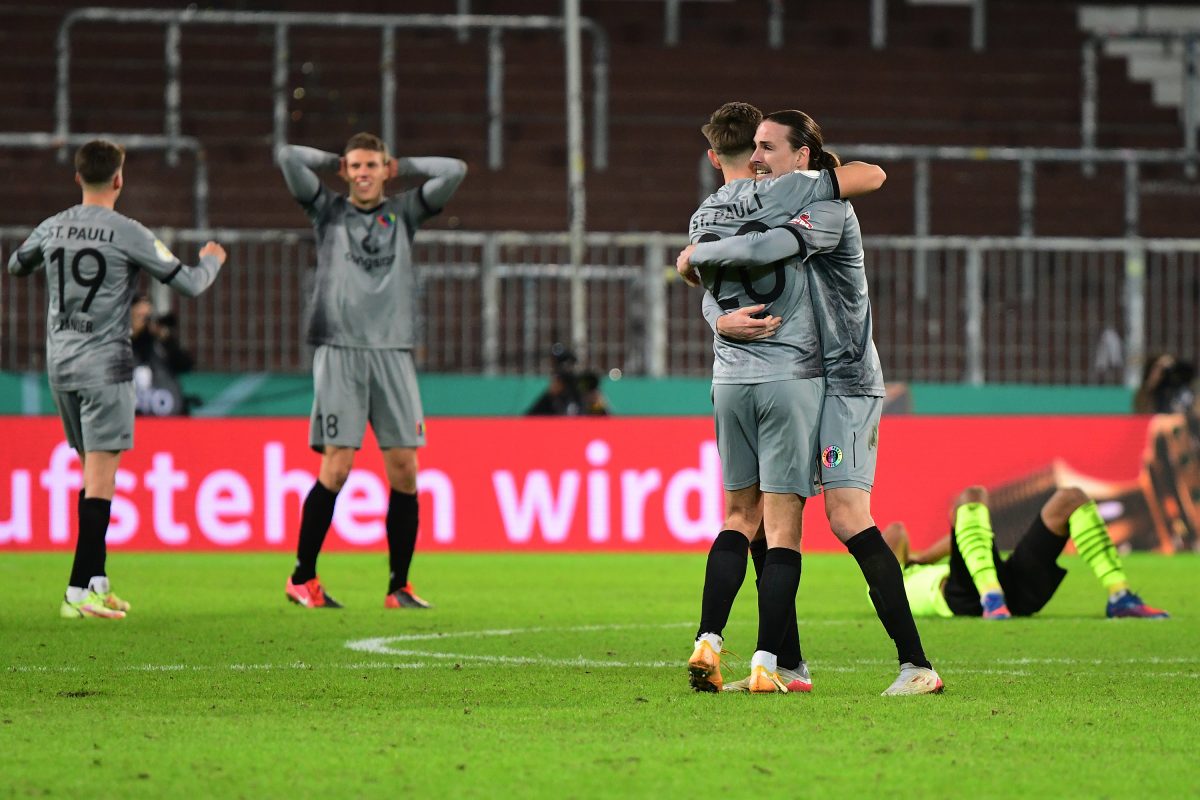
Diese Leistung des FC St. Pauli, wie um jeden Meter gekämpft, jeder Weg gegangen wurde, sie macht mich stolz. Ich denke selbst wenn der FCSP dieses Spiel noch verloren hätte, wäre dieses Gefühl bestehen geblieben. Das war eine Meisterleistung!
Was aber auch klar wurde an diesem Abend: Der FC St. Pauli kann mithalten. Er kann auch gegen ein Team wie Borussia Dortmund Tore erzielen. Er kann es mit einem Weltklasse-Stürmer und einem überragenden Mittelfeld aufnehmen. Er kann diese starke Offensive mit eigenen Mitteln in Schach halten und trotzdem noch Gefahr erzeugen. Gestern wurde einmal mehr klar, dass dieses Team in dieser Saison Großes schaffen kann.
Immer weiter vor!
//Tim
Alle Beiträge beim MillernTon sind gratis. Wir freuen uns aber sehr, wenn Du uns unterstützt.
MillernTon auf BlueSky // Mastodon // Facebook // Instagram // Threads // WhatsApp // YouTube
{:}{:en}What. Kind. Of. An. Evening! FC St. Pauli wins the DFB Cup against Borussia Dortmund and is through to the quarter-finals. In an intense game, FC St. Pauli managed to keep Dortmund’s high-quality attack in check with a new system and a lot of commitment. The deserved reward is the DFB Cup quarter-finals!
(Cover picture: Peter Böhmer)
With the right kind of honour, the FC St. Pauli team bus was accompanied from Budapester Straße to the stadium with pyrotechnics. Despite the few spectators in the stadium, there was a lot of action from the very first minute, and both in the stands and on the pitch, everyone gave their all for a successful game. There were a few surprises before kick-off:
The line-up
FC St. Pauli made three changes compared to the match against Erzgebirge Aue. James Lawrence started in central defence in place of Philipp Ziereis. Lawrence also took over the captain’s armband from Ziereis and should be a very unpleasant opponent for Erling Haaland. Very rarely does it fit with the actual starting line-up, which I scrub to myself in the preliminary report, but this time a bit more: In the midfield line-up Finn Ole Becker came in for Christopher Buchtmann. In addition, Etienne Amenyido started alongside Guido Burgstaller in the attack. Missing from the squad was Igor Matanović, who was „slightly ill“ according to Schultz. Simon Makienok and Luca Zander returned to the squad (and later to the pitch).
Borussia Dortmund also made a few changes compared to the successful match last weekend: Manuel Akanji replaced the injured Emre Can in central defence. Thomas Meunier was fit in time after all and played on the right side of the defence. In defensive midfield, Axel Witsel replaced Mo Dahoud at short notice, who was not even in the squad due to thigh problems (an enormous weakening, as would become apparent in the game). At the attacking outside position, BVB coach Marco Rose brought in Thorgan Hazard for Donyell Malen at the start.

And again: The early bird
By now, the word should have spread about what happens at the Millerntor shortly after kick-off this season: FC St. Pauli is an early bird. Again and again. What didn’t work against Erzgebirge Aue for once, worked all the better against Dortmund. FCSP took an early lead. Just like this season against Kiel (11th minute), Dresden (2nd minute), Rostock (12th) and also against Schalke (20th) – FC St. Pauli put a big, very big exclamation mark on the game.
It became clear right from the start that Finn Ole Becker was a good idea: He showed what his greatest strength is and played a pass into the final third to Jackson Irvine, who was closely pressed by four Dortmund players. He passed to the right into the depths to Hartel. That’s another change that paid off right at the start: Irvine, according to Schultz, operated offensively in the ten position but kept moving out to the right (which is why I would almost call it more of a 4-3-3, the way FCSP set up offensively). Marcel Hartel also moved out wide and even deeper in that situation. That too, the deep runs of the two eights, is a requirement of the coaching team.
Hartel played the pass in to Etienne Amenyido, who now showed in his second game after the winter break that he can score goals. Timo Schultz said in our podcast „We see an incredible amount in Eti“ and yesterday you could see in some situations what he meant by that (and it also showed that the thesis I put up in the podcast that Amenyido is not a goal scorer is pretty much humbug). In any case, Amenyido’s 1-0 was the perfect start to an increasingly exciting cup match. After two minutes played, a nice and cosy cup evening, which FC St. Pauli deserved, suddenly turned into a serious affair. After two minutes, everyone realised that something was possible this evening. Everyone realised that this evening with a game against the defending champions was the reward for two successful games before, but that FCSP’s cup journey could unexpectedly go further. In any case, I had a mighty pulse after two minutes.
Say hello to 4-4-2(flat)!
After this perfect start, however, FC St. Pauli first had to concentrate on its defence. Borussia Dortmund had full control of the action after the goal until around the 25th minute and had some good offensive actions. So it was time to take a look at FC St. Pauli’s defensive behaviour:
For about a year, FCSP had been operating almost exclusively with a midfield diamond, offensively and defensively. This changed with last night’s game. FC St. Pauli changed their system: Offensively it was still a 4-4-2 with a diamond (and with Irvine on the 10), but defensively FC St. Pauli played a clear 4-4-2(flat), i.e. a system with two sixes. Irvine dropped to the level of Eric Smith so that FCSP formed a neat four-man midfield.

(c) Peter Böhmer
This system became more stable from minute to minute but had to survive some difficult moments, especially at the beginning. With two four-man backs, FC St. Pauli stood very compact, especially in the centre, and was thus able to accommodate BVB’s playful central midfield with Bellingham, Brandt and Reus well. However, every system offers spaces somewhere. The flat 4-4-2 offers these on the outer lanes. BVB subsequently looked for exactly these spaces, pushing extremely high on the right side with full-back Thomas Meunier. Raphael Guerreiro did not do that on the left. He mostly moved into the half-space and it was alternately Bellingham, Reus, Brandt or Hazard who gave Dortmund’s game the necessary width by positioning themselves wide on the left. Yes, there were all four players in rotation. The BVB midfield rotated enormously and the players happily changed positions. FC St. Pauli, however, did not let themselves be disturbed by this and solved it with an almost consistent space defence against these rotations. Thus, it only became really dangerous when BVB massively overloaded the sides, i.e. when several players moved to one side. But this was not enough for BVB coach Marco Rose. At the PK after the match, he complained that his team „lacked width„.
What FC St. Pauli lacked in those first 25 minutes was defensive stability on Dortmund’s deep balls, as Timo Schultz told us after the match. Dortmund had great chances when the players on the outer positions went deep, i.e. when they sprinted from their midfield position towards the FCSP goal and were looked for with a long ball (in handball you would shout „run-in“). This is how the great chances of Hazard (7th minute) and Reus (17th) came about. Both times they appeared completely free in front of the FCSP goal. It could have all gone very differently… But it’s Pokal and that means we can finally, more than 18 months after it hit FC St. Pauli, write it out loud: SMARSCH! AHAAAAAA… SAVIOR OF THE UNIVERSE!
It was simply great what Dennis Smarsch showed in the FC St. Pauli goal yesterday. Not only did he save these two great chances, but he also radiated a remarkable calmness. Especially against the background that he is only used in the cup, I found this calmness, which seemed to affect the backline, remarkable. Accordingly, I am very happy for him that he will play (at least!) one more game this season and joyfully note that there seems to be a real luxury situation in goal at FCSP.

From the 25th minute onwards, however, FC St. Pauli became more stable. This did not mean that they had more possession, but they now managed better and better to keep the spaces tight. Even then, when BVB tried to play the width, for example via quick shifts. After the game, Schultz singled out his two eights in particular, who had defended these situations „with a lot of running effort.
Both ensured that the FC St. Pauli formation absorbed Dortmund’s eights Brandt and Bellingham well, without having to sacrifice their full-backs and without there being too many holes in the centre.
Until half-time, the game was more open and FC St. Pauli managed to relieve the pressure again and again. This was possible because the 4-4-2 was a bit higher and did not expect BVB deep in their half so that transitioning moments could be played out as such. Such a transitioning moment then also developed when Jakov Medić defended courageously and uncompromisingly against Marco Reus in the 40th minute and subsequently went forward. Seconds later, Burgstaller brought the ball into the centre, where Axel Witsel unhappily deflected into his own goal. That was almost emblematic of Witsel’s performance. Mo Dahoud’s absence weighed more heavily than many had assumed before the game. In the games before, Dahoud had created many offensive actions from the six-man position. Especially in the first half, little went through Witsel.
BVB adjusts and scores
For the second half, BVB made slight adjustments to their formation. Marco Rose (who seemed visibly annoyed at the press conference) emphasised that Axel Witsel should no longer play in front of FCSP’s first pressing line, but behind it, and that Dortmund generally wanted to occupy the interfaces better and also, where was he in the first half, create „more depth“ for Erling Haaland. The change in Witsel’s positioning allowed the central teammates to push a little further up or out.
Rose also said, however, that he had expected FC St. Pauli to play „differently against the ball“. Despite the change in the second half, Borussia Dortmund now rarely managed to become dangerous despite having a kind of visual superiority. FC St. Pauli’s 4-4-2 developed into an impenetrable bulwark. It was almost palpable how the FCSP players trusted this formation more and more, how they improved by the minute and did not lose focus and discipline in difficult phases.
Nevertheless, it was certainly clear to everyone in the stadium and elsewhere that the adrenaline level would increase by the minute in the 2nd half. A cup game is a cup game. Anything is always possible. I first looked at the clock in the 47th minute to see when the game would finally be over. 47TH MINUTE ONLY! The second half already seemed to last forever. Then it dawned on me all the more that I had a very long battle with my emotions ahead of me in the press tribune, between the haggling reporters from Dortmund.
BVB had the first offensive actions after the break, but the first exclamation mark was made by Guido Burgstaller with a header after a Smith standard, which was parried quite strongly by Dortmund’s Kobel (53rd minute). Shortly afterwards, a cry from all Dortmund players: the situation was difficult to perceive, not only for me in the stadium, but at the latest when referee Harm Osmers grabbed his ear and then ran towards the touchline, the Millerntor briefly consisted of a loud sigh – penalty for Dortmund. Erling Haaland, who had been surprisingly pale up to that point and even paler in the aftermath, converted safely in the 58th minute. 35 minutes left. And Dortmund had tied the game up. My mood was at its lowest point. Despite the lead, it was clear to me that things would go their usual course from now on. I had hoped that FCSP would hold on to the 2-0 lead for maybe 20 or even 25 minutes in the second half. Until Dortmund would become nervous and then inaccurate, as we experienced against Aue.

(Stuart Franklin/Getty Images/via OneFootball)
But nobody at FC St. Pauli became nervous. It rather seemed that they played their system even more disciplined after the break. The gaps between the players became even smaller and they managed to relieve the pressure again and again. From minute 60 at the latest, it was what you call a cup fight. However, it seemed to be one-sided. The coaches‘ opinions after the game were contradictory: Rose accused his team of „not taking the fight“, while Schultz saw a „great cup fight from my team“.
The longer it took, the more stable FC St. Pauli became.
Despite the „lack of energy“ according to Rose, BVB did not remain harmless. In the phase between the 70th and 80th minute, FC St. Pauli let themselves be pushed far, very far, certainly a little too far into their half. In the first 25 minutes, BVB had slightly bigger chances, but those 10 minutes in the middle of the 2nd half were probably the most difficult for FC St. Pauli. But while I was impatiently staring at the clock, the team did not let itself be distracted from its disciplined way of playing, continued to go enormous ways in the defence, thus keeping the distances between each other small and was able to clear one time and another. However, as the team stood very deep, there were also very few relief actions. When FC St. Pauli possessed the ball for long periods, Jackson Irvine didn’t even advance properly and Eric Smith pumped precariously every time the game was stopped.
It was the back four that carried FC St. Pauli through this phase. Actually, every phase of the game can be attributed to players: The start went to the offensive department, Smarsch saved strongly several times after that, and until half-time, it was the well-set midfield chain that took the teeth out of Dortmund’s play. In the middle of the second half, it was the back four with the fantastic Sebastian Ohlsson, who repeatedly faced changing opponents on his side and won a fabulous 11 of 13 duels (also strong: Jackson Irvine won 11 of 15 – and Jakov Medić simply won all(!) his direct duels on the ground…).
FC St. Pauli remained disciplined in their 4-4-2, Dortmund looked increasingly unnerved and also somewhat helpless. From the 80th minute onwards, it was noticeable that BVB somehow seemed a little broken. There were also more relief actions again. Guido Burgstaller now appeared more often, was able to secure many balls in front and win time (it was then his phase – unbelievable how he consistently ran into the opponents in full sprint even shortly before the end). At the very end of the game, when Mats Hummels had already broken up his position and was standing in front („did it ever help that he was standing in front?!“ was the unnerved comment of the reporters next to me), FC St. Pauli had some very good counter-attacking opportunities. They were so good, I would have bitten the table afterwards if BVB had equalised.
But they didn’t. No, they simply didn’t. With an unbelievable will, iron discipline, loud 2,000 spectators behind them and, of course, the necessary portion of luck, FC St. Pauli managed to hold on to the narrow lead – Cup winners, quarter-finalists, already qualified for the World Cup – great cinema!

This performance of FC St. Pauli, how they fought for every metre, how they went every way, makes me proud. I think even if FC St. Pauli had lost this game, this feeling would have remained. That was a masterstroke!
But what also became clear that evening: FC St. Pauli can keep up. It can also score goals against a team like Borussia Dortmund. It can take on a world-class striker and an outstanding midfield. He can keep this powerful offence in check with his resources and still create danger. Yesterday it became clear once again that this team can achieve great things this season.
Keep moving forward!
//Tim (translation by Arne)
MillernTon Twitter //
MillernTon YouTube //
MillernTon Facebook //MillernTon Instagram //
If you like what we do here, here you’ll find the information on how to support us.
{:}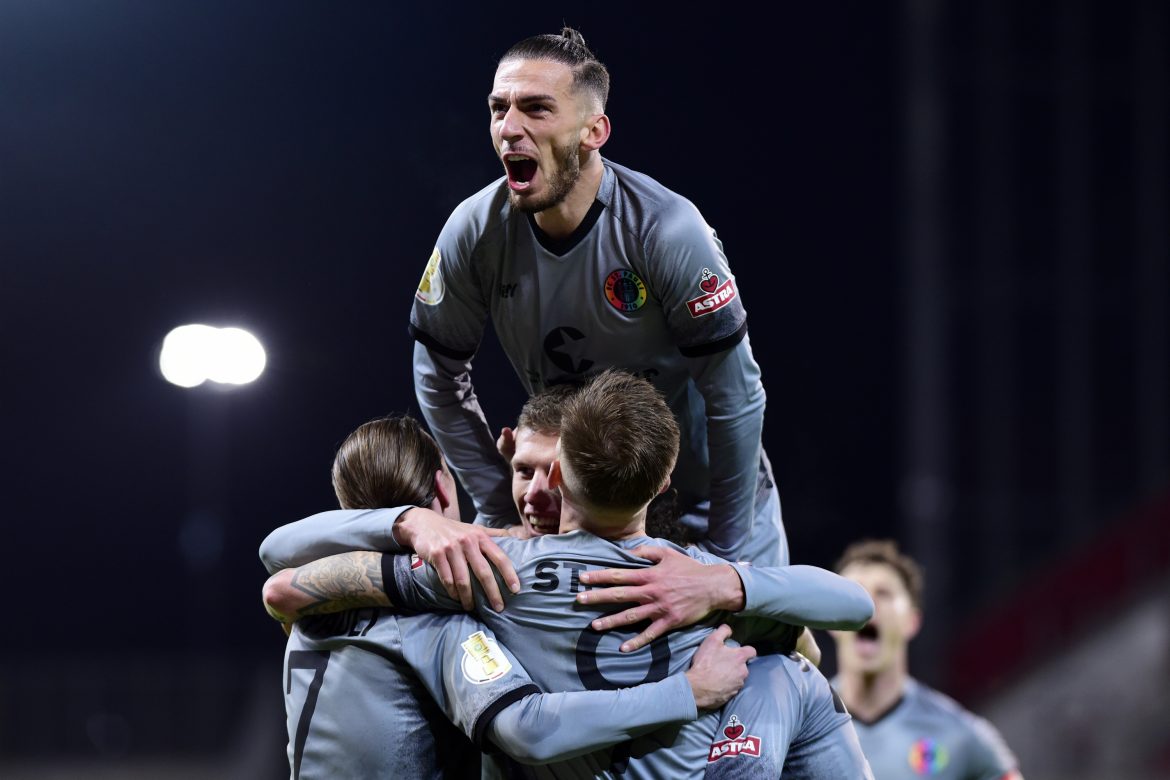

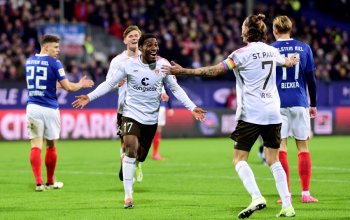
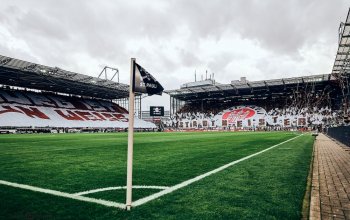

Geht doch ;-).
Ich sehe die Schwachstellen des Flächen 442 allerdings nicht auf den Außenbahnen, die sind im Gegensatz zum Diamant 😉 ja doppelt besetzt. Problemzonen liegen eher zwischen den Ketten, wenn dort die Abstände zu groß sind, bzw. dass der Weg in offensiven Umschaltsituationen gerade von außen sehr weit werden kann und dadurch kein Druck auf den Gegner ausgeübt wird.
Ja, das stimmt grundsätzlich, dass die Außenbahnen doppelt besetzt sind und die Bewegungen zwischen den Ketten ein Problem werden können (was ja auch der Grund war, warum diese Formation vor zehn Jahren erst einmal ausgestorben ist). Beim FC St. Pauli haben sie es aber sehr zentrumsfokussiert gespielt und hatten entsprechend viel zu Verschieben, weil der BVB die Außenbahnen radikal besetzte. Daher meine Aussgae, dass dieses 4-4-2 Raum auf der Außenbahn gibt.
Am Fernseher sah es für mich so aus, als ob sehr weit ballorientiert verschoben wurde. Aber durch den Wechsel zwischen Diamant und flacher Formation kann natürlich auch eine Zentrumsorientierung entstehen.
Ich würde da einen Unterschied zwischen Becker/Hartel und Irvine/Smith. Erstere sind schon weit rausgeschoben. Letztere bildeten dann ne Dreierkette mit dem ballfernen Achter. Ist noch schwer für mich das genau zu beschreiben. Ich könnte mir aber vorstellen, dass wir das amFreitag wiedersehen
Diese Ungenauigkeiten im letzten Zuspiel und oftmals zu langsame Ballannahme und -weiterleitungen haben mich wahnsinnig gemacht. Klar war das insgesamt eine tolle Leistung, aber keine Meisterleistung. Gegen einen BVB in Topform gewinnst du das Spiel so nicht.
Ja, keine Frage, der BVB hatte auch nicht seinen besten Tag. Aber der FCSP hat es geschafft das Spiel des BVB auch so zu stören, dass sie sich nicht in Topform spielen konnten. Das war dann auch die Meisterleistung, also die Arbeit gegen den Ball.
Gegen einen BVB in Topform gewinnst du als Zweitligist auch mit einer eigenen Topleistung nicht.
Das war „Gras fressen“ auf ganz hohem Niveau! Grade in den letzten 20 Minuten. Hut ab vor der Leistung der ganz Mannschaft.
Eine Frage noch zum 2:0. wäre das ein Abseitstor von Amenyido gewesen, wenn Witzel den Ball durchgelassen hätte? Trotz Wiederholungen bin ich mir nicht sicher.
Hatte ich mich gestern auch gefragt. Ich glaube aber schon. Denn er wäre erst passiv und dann aktiv gewesen, ohne das es eine neue Spielsituation gewesen wäre, oder?
Das ist dann eine neue Spielsituation. Im übrigen war Amenyido „aktiv“, da er Witsel zu einer Abwehraktion gezwungen hat. Hätte er dort nicht gestanden, hätte Witsel ihn theoretisch gefahrenlos durchlassen können.
Unsere Freistoßvariante, die gerade zu Anfang der Saison erfolgreich war, spielt ja das selbe Prinzip:
1,2 Spieler stehen im 16er im Abseits, der Ball wird auf Kyereh auf Außen gechipt, welcher den Ball dann auf die nicht mehr im Abseits positionierten Spieler direkt weitergibt.
Schon komisch, dass das gestern gar kein Thema war.
Das kann ich ja mal beantworten: Nein, bei der Flanke handelt es sich definitiv um eine neue Spielsituation, das vorherige passive Abseits ist dann schon vorbei.
Gegenbeispiel: Bei Freistößen aus dem Halbfeld sieht man ja auch häufig, wie Spieler bewusst (weit) im Abseits stehen. Die warten dann ja nur darauf, dass der Ball reinkommt, jemand anderes dann reingelaufen ist und sie den dann bekommen. Auch da ist es ja keine neue Spielsituation.
Ich auch nicht
Ich traue mich einfach mal, meine unqualifizierten Bemerkungen unter diesen – wie immer – exzellenten Bericht zu schreiben.
Bemerkenswert war, dass es keine einzige gelbe Karte gab. Und zum Elfmeter: Für mich hat Hummels den Ball Jakov mit voller Absicht
an die Hand gespielt. Sein Blick geht genau da hin und es war kein Dortmunder in der Nähe, der den Ball hätte erreichen können.
Von daher hat es diesmal doch was gebracht, dass der da vorne war. Irgendwann habe ich mal bei Collinas Erben gehört, dass bei diesen
hochklassigen Spielern nichts zufällig geschieht.
So, und jetzt freue ich mich einfach still weiter.
Ja, die Anzahl an Fouls und auch die Anzahl an Karten war, besonders für ein Pokalspiel, sehr gering. Das haben wir auch notiert, ich verweise aber hiermit darauf, dass da im Laufe des Tages vermutlich noch was zu kommt.
Und natürlich sind deine Bemerkungen hier herzlich willkommen. Unqualifiziert sind sie definitiv nicht.
Der erste Kontakt/die Ballmitnahme von Amenyido vorm 1-0 war sensationell. Wenn so gewollt sogar Weltklasse.
Ist Smarsch eigentlich nächste Saison die Nummer 1 auch für die Liga?
Tja, gute Frage. Nikola Vasilj macht das auch sehr, sehr gut. Es ist eine Luxus-Situation im Tor.
(ich glaube, dass der Kontakt von Amenyido nicht ganz beabsichtigt war)
Danke für Deinen Bericht und ganz viel Liebe für die Menschen rund um die Stadionbeschallung für das perfekte Timing von Antifa Hooligans! War für mich das i-Tüpfelchen.
Immer wieder gut, aber dieses Mal noch etwas besser, dass das zum Ende der Halbzeit läuft.
Warum, was war an der Halbzeit anders als sonst?
Die spielen das üblicherweise im letzten Drittel der Halbzeitpause. Diesmal lief es kurz vor dem Ende. Gefühlt musste der Schiedsrichter mit dem Anpfiff warten bis der letzte Akkord gespielt war. Ich kann mir gut vorstellen das es eine kleine Retourkutsche dafür war das die DFB-Pokal-Hymne unser Hells-Bells abgewürgt hat.
Zum Thema Karten: Ich hätte als Schiri Bellingham direkt zum Auflaufen noch vorm Anstoß eine gelbe Karte gegeben, nur damit der nicht jede, JEDE (!!einself) Situation mit ungläubigem Entsetzen über die völlig korrekten Entscheidungen gegen sich lautstark bemängelt hätte!
Sehr starker Bericht! Was bei dem ganzen (berechtigten!) Lob für die Mittelfeldkette von alle Seiten ein bisschen kurz kommt, ist meiner Meinung nach die Arbeit der Abwehrreihe. Deswegen freut es mich sehr zu lesen, wie hier die einzelnen Spielphasen zugeschrieben wurden, so hab ich es auch wahrgenommen. Die Ruhe, die Smarsch ausgestrahlt hat, war so stark, das hat man daran gesehen, mit welcher Brust die Verteidiger in die Zweikämpfe gegangen sind. Haaland hat zwischen Medic und Lawrence quasi gar nicht stattgefunden (zumindest nicht in seiner bekannten „Weltklasse“) und Ohlsson… WOW. Wie er sich in die Zweikämpfe gegen seine wechselnden Gegenspieler gebissen hat, bockstark! An der Stelle noch ein Lob an einen Spieler, der in dem Bericht nicht erwähnt wurde: Luca Zander, hat Ohlsson beinahe 1:1 ersetzt und das obwohl er sich dann auch mit dem ebenfalls frischen Malen rumschlagen musste. Wenn man dann noch sieht, wie ein sichtlich erschöpfter Irvine in der 80. Minute ein eigentlich aussichtsloses Laufduell mit Hummels annimmt, ist klar, dass das genau der Kampf war, der uns gestern die frühe Führung über die Zeit gebracht hat.